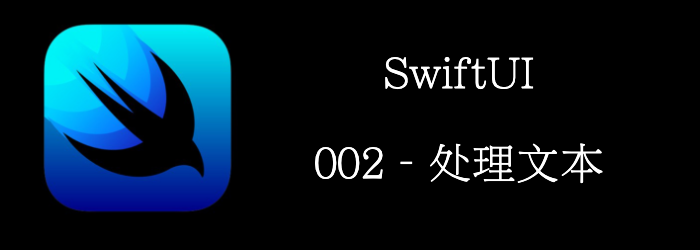 文本是任何App的一个基础。
本章我们将介绍:
文本是任何App的一个基础。
本章我们将介绍:
- Text
- TextField
- SecureField
- TextEditor
准备
创建一个名为FormattedText的新 SwiftUI 项目。
怎么做…
首先将Text用VStack包裹一下
struct ContentView: View {
var body: some View {
VStack{
Text("Hello World")
}
}
}
然后添加一个fontWeight modifier。
Text("Hello World").fontWeight(.medium)
添加两个个state
@State var password = ""
@State var someText = ""
添加一个Text和SecureField, 用Text显示SecureField的输入
SecureField("Enter a password", text: $password).padding()
Text("password entered: \(password)").italic()
添加一个Text和TextField,用Text显示TextField的输入
TextField("Enter some text", text: $someText).padding()
Text("\(someText)").font(.largeTitle).underline()
再尝试一下其他modifier
Text("Changing text color and make it bold").foregroundColor(Color.blue).bold()
Text("Use kerning to change space between lines of text").kerning(7)
Text("Changing baseline offset").baselineOffset(100)
Text("Strikethrough").strikethrough()
Text("This is a multiline text implemented in SwiftUI. The trailing modifier was added to the text. This text also implements multiple modifiers")
.background(Color.yellow)
.multilineTextAlignment(.trailing)
.lineSpacing(10)

How it works…
Text有关于font,spacing等相关的Modifier。TextFiled和SecureField都需要一个State来存储输入,我们可以使用@State来声明一个State。SwiftUI会在State改变时,自动刷新UI。
我们通过$来绑定State。
TextField("Enter some text", text: $someText)
There's more…
我们继续添加Text,当子视图超过10个时,就会报错。原来是SwiftUI只支持最大10个子视图。所以此时,我们需要使用Group来分割我们的子视图。
详细介绍
Text
用于显示1行或者多行的只读文本。
Creating a Text View from a String
//国际化
init(_ key: LocalizedStringKey, tableName: String? = nil, bundle: Bundle? = nil, comment: StaticString? = nil)
//普通字符串,无国际化
init<S>(_ content: S) where S : StringProtocol
//富文本
init(_ attributedContent: AttributedString)
Creating a Text View for a Date
// 显示某个时间范围3:09-3.10 PM
init(_ dates: ClosedRange<Date>)
init(_ interval: DateInterval)
// 显示日期, 按照style
init(_ date: Date, style: Text.DateStyle)
Creating a Text View with Formatting
显示非string对象, 需要你的type遵循FormatStyle协议。
init<F>(_ input: F.FormatInput, format: F) where F : FormatStyle, F.FormatInput : Equatable, F.FormatOutput == String
init<Subject>(_ subject: Subject, formatter: Formatter) where Subject : ReferenceConvertible
init<Subject>(_ subject: Subject, formatter: Formatter) where Subject : NSObject
我们也可以实现自己的formater。比如我们要格式化日期为yyyy-MM-dd。但默认Date.FormatStyle提供的似乎不够用,我们可以实现自己的formater。
struct YYYYMMddDateStyle: FormatStyle {
typealias FormatInput = Date
typealias FormatOutput = String
static let dateFormater: DateFormatter = {
let formater = DateFormatter()
formater.dateFormat = "yyyy-MM-dd"
return formater
}()
func format(_ value: Date) -> String {
return YYYYMMddDateStyle.dateFormater.string(from: value)
}
}
/// 扩展一下FormatStyle,这样就有提示了
extension FormatStyle where Self == YYYYMMddDateStyle {
static var yyyyMMddDateStyle:YYYYMMddDateStyle { return .init() }
}
//使用
struct ContentView: View {
var body: some View {
Text.init(Date(), format: .yyyyMMddDateStyle)
}
}
Creating a Text View from an Image
将图片包裹为Text,适合和其他Text拼接。
init(_ image: Image)
例子:
struct ContentView: View {
@State var password = ""
@State var someText = "Initial text"
var body: some View {
Text("hello") + Text(Image("my-img-name")) + Text("world")
}
}
Choosing a Font
字体相关:
func font(Font?) -> Text
func fontWeight(Font.Weight?) -> Text
Styling the View’s Text
文本样式
func foregroundColor(Color?) -> Text
func bold() -> Text
func italic() -> Text
func strikethrough(Bool, color: Color?) -> Text
func underline(Bool, color: Color?) -> Text
func monospacedDigit() -> Text
func kerning(CGFloat) -> Text
func tracking(CGFloat) -> Text
func baselineOffset(CGFloat) -> Text
func textCase(Text.Case?) -> some View
Fitting Text into Available Space
缩放相关:
func allowsTightening(Bool) -> some View//是否允许缩放两个字符间的间距
func minimumScaleFactor(CGFloat) -> some View//缩放字体
func truncationMode(Text.TruncationMode) -> some View//截断
Handling Multiline Text
处理多行文本
func lineLimit(Int?) -> some View
func lineSpacing(CGFloat) -> some View
func multilineTextAlignment(TextAlignment) -> some View
其他
还有些voiceover和accessbility相关的功能,可以暂时忽略
TextField
输入框。
Creating a Text Field with a String Value
textfield和string绑定。需要3个东西: title, binding和prompt。
init(_ titleKey: LocalizedStringKey, text: Binding<String>, prompt: Text?)
init<S>(_ title: S, text: Binding<String>, prompt: Text?) where S : StringProtocol
init(text: Binding<String>, prompt: Text? = nil, label: () -> Label)
注意title和prompt的区别。
Form {
TextField(text: $username, prompt: Text("Required")) {
Text("Username")
}
SecureField(text: $password, prompt: Text("Required")) {
Text("Password")
}
}
在macOS上:前面的文字是title/label。placeholder是prompt。

在ios上,不会单独显示label,如果提供了prompt,则用prompt作为placeholder,没有提供则用title/label作为placeholder。

Creating a Text Field with an Arbitrary Value
TextField并不一定只能binding到String,可以Binding到任何类型,只是需要一个ParseableFormatStyle 或者 Formatter。
init<F>(_ titleKey: LocalizedStringKey, value: Binding<F.FormatInput>, format: F, prompt: Text? = nil) where F : ParseableFormatStyle, F.FormatOutput == String
init<S, F>(_ title: S, value: Binding<F.FormatInput>, format: F, prompt: Text? = nil) where S : StringProtocol, F : ParseableFormatStyle, F.FormatOutput == String
init<F>(value: Binding<F.FormatInput>, format: F, prompt: Text? = nil, label: () -> Label) where F : ParseableFormatStyle, F.FormatOutput == String
init<V>(_ titleKey: LocalizedStringKey, value: Binding<V>, formatter: Formatter, prompt: Text?)
init<S, V>(_ title: S, value: Binding<V>, formatter: Formatter, prompt: Text?) where S : StringProtocol
init<V>(value: Binding<V>, formatter: Formatter, prompt: Text? = nil, label: () -> Label)
我们来举个例子,将一个Person绑定到TextField。TextField显示firstName lastName。
先定义Person
struct Person {
var firstName = ""
var lastName = ""
}
定义解析策略,负责将String解析成Person
/// 解析,负责将string解析成自定义类型
struct PersonParseStrategy: ParseStrategy {
typealias ParseInput = String
typealias ParseOutput = Person
func parse(_ value: String) throws -> Person {
var components = value.components(separatedBy: " ")
if components.isEmpty {
return Person()
} else if components.count == 1 {
return Person(firstName: components[0], lastName: "")
} else {
let firstName = components[0]
components.removeFirst()
let lastName = components.joined(separator: " ")
return Person(firstName: firstName, lastName: lastName)
}
}
}
定义FormatStyle,负责将Person格式化为String
/// formater, 负责将自定义类型解析成textfield的显示
struct PersonNameFormatStyle: ParseableFormatStyle {
typealias Strategy = PersonParseStrategy
typealias FormatInput = Person
typealias FormatOutput = String
var parseStrategy = PersonParseStrategy()
func format(_ value: Person) -> String {
return "\(value.firstName) \(value.lastName)"
}
}
@available(iOS 15.0, *)
extension ParseableFormatStyle where Self == PersonNameFormatStyle {
static var personNameFormatStyle: PersonNameFormatStyle { .init() }
}
使用
struct ContentView: View {
@State var person = Person()
var body: some View {
TextField("请输入姓名", value: $person, format: .personNameFormatStyle, prompt: nil)
Text("firstName:\(person.firstName) lastName:\(person.lastName)")
}
}
Creating a Text Field with an Arbitrary Optional
和上面的类似,只是支持Optional
init<F>(_ titleKey: LocalizedStringKey, value: Binding<F.FormatInput?>, format: F, prompt: Text? = nil) where F : ParseableFormatStyle, F.FormatOutput == String
....省略
Styling Text Fields
设置text field的style
func textFieldStyle<S>(_ style: S) -> some View where S : TextFieldStyle
举例
TextField("请输入姓名", value: $person, format: .personNameFormatStyle, prompt: nil)
.textFieldStyle(.roundedBorder)
常用的UITextFieldDelegate对比
.editingChanged
TextField("", text: $password)
.onChange(of: password) { newValue in
password = Format(password)
}
.editingDidBegin / .editingDidEnd
@FocusState var isFocused: Bool
TextField("", text: $password)
.focused($isFocused)
.onChange(of: isFocused) { newValue in
print("current foucus state \(newValue)")
}
textShouldReturn
TextField("", text: $password)
.onSubmit {
print("clicked return btn")
}
SecureField
只能binding到string,不能像TextField一样可以绑定任何值。
没有显示真实输入密码的功能。要实现眼睛功能,只有用TextField和SecureField一起。
Creating a Secure Text Field
和texfiled类似
init<S>(_ title: S, text: Binding<String>, prompt: Text?) where S : StringProtocol
Configuring Text Entry
func keyboardType(_ type: UIKeyboardType) -> some View //键盘类型
func disableAutocorrection(_ disable: Bool?) -> some View //自动修正
func textInputAutocapitalization(_ autocapitalization: TextInputAutocapitalization?) -> some View //自动首字母大小写
//设置文本类型,系统会根据类型为输入提供建议
func textContentType(_ textContentType: UITextContentType?) -> some View
TextEditor
显示和编辑多行较长的文本
Creating a Text Editor
init(text: Binding<String>)
Styling the View’s Text
func font(_ font: Font?) -> some View
func foregroundColor(_ color: Color?) -> some View
func multilineTextAlignment(_ alignment: TextAlignment) -> some View
func lineSpacing(_ lineSpacing: CGFloat) -> some View
func allowsTightening(_ flag: Bool) -> some View
Managing Text Entry
func textInputAutocapitalization(_ autocapitalization: TextInputAutocapitalization?) -> some View
func disableAutocorrection(_ disable: Bool?) -> some View
func keyboardType(_ type: UIKeyboardType) -> some View